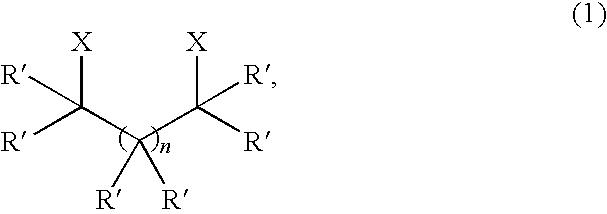Method of Preparing Cyclic Carbonates, Cyclic Carbamates, Cyclic Ureas, Cyclic Thiocarbonates, Cyclic Thiocarbamates, and Cyclic Dithiocarbonates
- Summary
- Abstract
- Description
- Claims
- Application Information
AI Technical Summary
Benefits of technology
Problems solved by technology
Method used
Image
Examples
examples 1-3
Preparation of Methyl-5-Benzyloxycarboxyl-1,3-Dioxan-2-One (MTC-Bn)
Optimization of Solvent
[0043]
example 1
[0044]In a flask, benzyl 2,2-bis(methylol)propionate (Bn-MPA) (0.500 g, 0.00222 mol, 1 eq.) was placed in tetrahydrofuran (THF, 20 ml), followed by PFC (0.875 g, 0.00222 mol, 1 eq.). CsF (84 mg, 0.555 mmol, 0.25 eq.) was added as a solid, and the solution was stirred for 24 hours at room temperature. A small aliquot was dried, and the solvent was replaced with CDCl3. Proton NMR of the crude product indicated approximately 70% conversion to 5-methyl-5-benzyloxycarboxyl-1,3-dioxan-2-one (MTC-Bn), and no trace of polycarbonate.
example 2
[0045]In a flask, Bn-MPA (0.500 g, 0.00222 mol, 1 eq.) was placed in dichloromethane (DCM, 15 ml), followed by PFC (0.875 g, 0.00222 mol, 1 eq.). CsF (84 mg CsF, 0.555 mmol, 0.25 eq.) was added as a solid, and the solution was stirred for 24 hours at room temperature. A small aliquot was dried out, and the solvent was replaced by CDCl3. Proton NMR of the crude indicated approximately 50% conversion to MTC-Bn, and no trace of polycarbonate.
PUM
 Login to View More
Login to View More Abstract
Description
Claims
Application Information
 Login to View More
Login to View More - R&D
- Intellectual Property
- Life Sciences
- Materials
- Tech Scout
- Unparalleled Data Quality
- Higher Quality Content
- 60% Fewer Hallucinations
Browse by: Latest US Patents, China's latest patents, Technical Efficacy Thesaurus, Application Domain, Technology Topic, Popular Technical Reports.
© 2025 PatSnap. All rights reserved.Legal|Privacy policy|Modern Slavery Act Transparency Statement|Sitemap|About US| Contact US: help@patsnap.com



